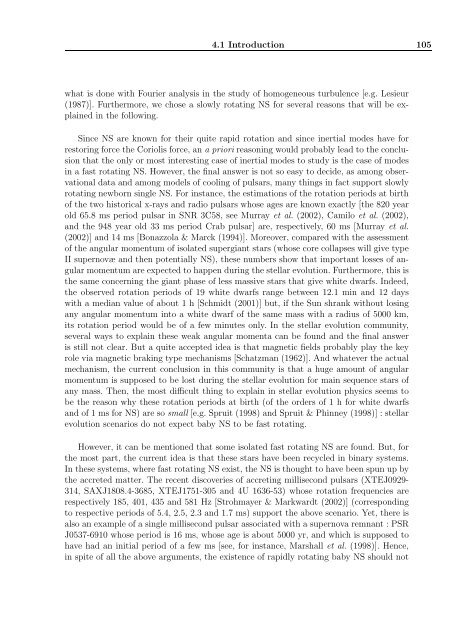Ecole doctorale de Physique de la région Parisienne (ED107)
Ecole doctorale de Physique de la région Parisienne (ED107)
Ecole doctorale de Physique de la région Parisienne (ED107)
Create successful ePaper yourself
Turn your PDF publications into a flip-book with our unique Google optimized e-Paper software.
4.1 Introduction 105<br />
what is done with Fourier analysis in the study of homogeneous turbulence [e.g. Lesieur<br />
(1987)]. Furthermore, we chose a slowly rotating NS for several reasons that will be exp<strong>la</strong>ined<br />
in the following.<br />
Since NS are known for their quite rapid rotation and since inertial mo<strong>de</strong>s have for<br />
restoring force the Coriolis force, an a priori reasoning would probably lead to the conclusion<br />
that the only or most interesting case of inertial mo<strong>de</strong>s to study is the case of mo<strong>de</strong>s<br />
in a fast rotating NS. However, the final answer is not so easy to <strong>de</strong>ci<strong>de</strong>, as among observational<br />
data and among mo<strong>de</strong>ls of cooling of pulsars, many things in fact support slowly<br />
rotating newborn single NS. For instance, the estimations of the rotation periods at birth<br />
of the two historical x-rays and radio pulsars whose ages are known exactly [the 820 year<br />
old 65.8 ms period pulsar in SNR 3C58, see Murray et al. (2002), Camilo et al. (2002),<br />
and the 948 year old 33 ms period Crab pulsar] are, respectively, 60 ms [Murray et al.<br />
(2002)] and 14 ms [Bonazzo<strong>la</strong> & Marck (1994)]. Moreover, compared with the assessment<br />
of the angu<strong>la</strong>r momentum of iso<strong>la</strong>ted supergiant stars (whose core col<strong>la</strong>pses will give type<br />
II supernovæ and then potentially NS), these numbers show that important losses of angu<strong>la</strong>r<br />
momentum are expected to happen during the stel<strong>la</strong>r evolution. Furthermore, this is<br />
the same concerning the giant phase of less massive stars that give white dwarfs. In<strong>de</strong>ed,<br />
the observed rotation periods of 19 white dwarfs range between 12.1 min and 12 days<br />
with a median value of about 1 h [Schmidt (2001)] but, if the Sun shrank without losing<br />
any angu<strong>la</strong>r momentum into a white dwarf of the same mass with a radius of 5000 km,<br />
its rotation period would be of a few minutes only. In the stel<strong>la</strong>r evolution community,<br />
several ways to exp<strong>la</strong>in these weak angu<strong>la</strong>r momenta can be found and the final answer<br />
is still not clear. But a quite accepted i<strong>de</strong>a is that magnetic fields probably p<strong>la</strong>y the key<br />
role via magnetic braking type mechanisms [Schatzman (1962)]. And whatever the actual<br />
mechanism, the current conclusion in this community is that a huge amount of angu<strong>la</strong>r<br />
momentum is supposed to be lost during the stel<strong>la</strong>r evolution for main sequence stars of<br />
any mass. Then, the most difficult thing to exp<strong>la</strong>in in stel<strong>la</strong>r evolution physics seems to<br />
be the reason why these rotation periods at birth (of the or<strong>de</strong>rs of 1 h for white dwarfs<br />
and of 1 ms for NS) are so small [e.g. Spruit (1998) and Spruit & Phinney (1998)] : stel<strong>la</strong>r<br />
evolution scenarios do not expect baby NS to be fast rotating.<br />
However, it can be mentioned that some iso<strong>la</strong>ted fast rotating NS are found. But, for<br />
the most part, the current i<strong>de</strong>a is that these stars have been recycled in binary systems.<br />
In these systems, where fast rotating NS exist, the NS is thought to have been spun up by<br />
the accreted matter. The recent discoveries of accreting millisecond pulsars (XTEJ0929-<br />
314, SAXJ1808.4-3685, XTEJ1751-305 and 4U 1636-53) whose rotation frequencies are<br />
respectively 185, 401, 435 and 581 Hz [Strohmayer & Markwardt (2002)] (corresponding<br />
to respective periods of 5.4, 2.5, 2.3 and 1.7 ms) support the above scenario. Yet, there is<br />
also an example of a single millisecond pulsar associated with a supernova remnant : PSR<br />
J0537-6910 whose period is 16 ms, whose age is about 5000 yr, and which is supposed to<br />
have had an initial period of a few ms [see, for instance, Marshall et al. (1998)]. Hence,<br />
in spite of all the above arguments, the existence of rapidly rotating baby NS should not
















